Page 356 of 561
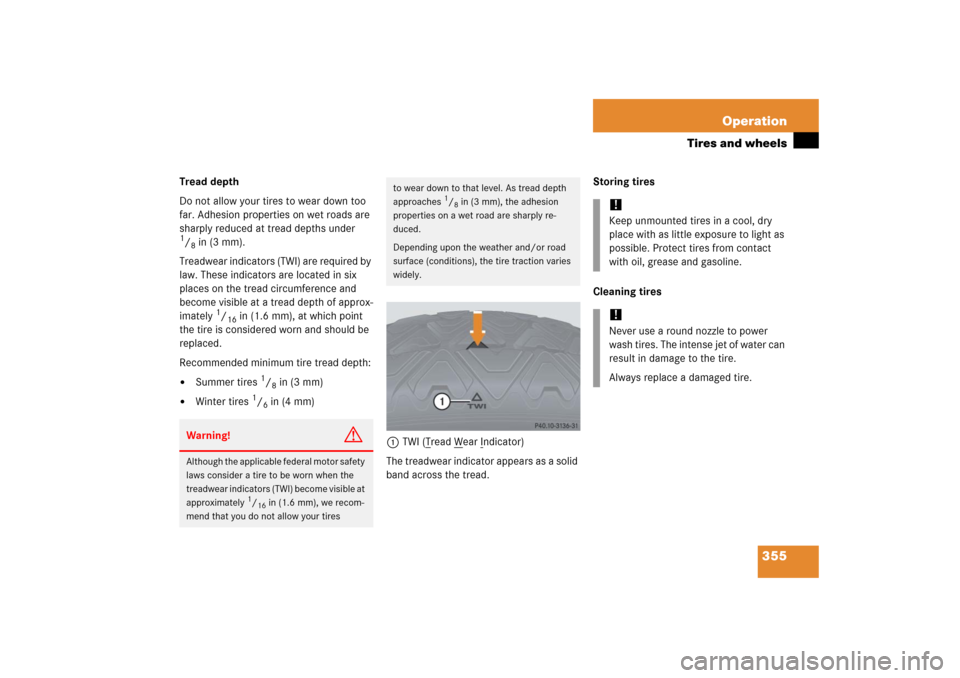
355 Operation
Tires and wheels
Tread depth
Do not allow your tires to wear down too
far. Adhesion properties on wet roads are
sharply reduced at tread depths under 1/8in (3 mm).
Treadwear indicators (TWI) are required by
law. These indicators are located in six
places on the tread circumference and
become visible at a tread depth of approx-
imately
1/16
in (1.6 mm), at which point
the tire is considered worn and should be
replaced.
Recommended minimum tire tread depth:
�
Summer tires
1/8in (3 mm)
�
Winter tires
1/6in (4 mm)
1TWI (T
read W
ear I
ndicator)
The treadwear indicator appears as a solid
band across the tread.Storing tires
Cleaning tires
Warning!
G
Although the applicable federal motor safety
laws consider a tire to be worn when the
treadwear indicators (TWI) become visible at
approximately
1/16in (1.6 mm), we recom-
mend that you do not allow your tires
to wear down to that level. As tread depth
approaches
1/8in (3 mm), the adhesion
properties on a wet road are sharply re-
duced.
Depending upon the weather and/or road
surface (conditions), the tire traction varies
widely.
!Keep unmounted tires in a cool, dry
place with as little exposure to light as
possible. Protect tires from contact
with oil, grease and gasoline.!Never use a round nozzle to power
wash tires. The intense jet of water can
result in damage to the tire.
Always replace a damaged tire.
Page 391 of 561
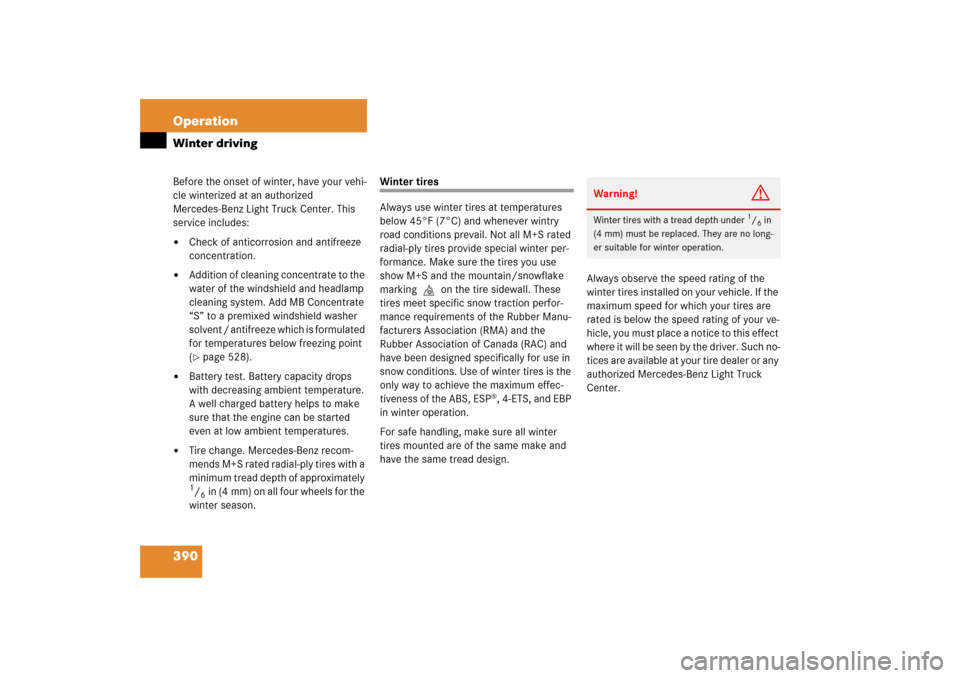
390 OperationWinter drivingBefore the onset of winter, have your vehi-
cle winterized at an authorized
Mercedes-Benz Light Truck Center. This
service includes:�
Check of anticorrosion and antifreeze
concentration.
�
Addition of cleaning concentrate to the
water of the windshield and headlamp
cleaning system. Add MB Concentrate
“S” to a premixed windshield washer
solvent / antifreeze which is formulated
for temperatures below freezing point
(�page 528).
�
Battery test. Battery capacity drops
with decreasing ambient temperature.
A well charged battery helps to make
sure that the engine can be started
even at low ambient temperatures.
�
Tire change. Mercedes-Benz recom-
mends M+S rated radial-ply tires with a
minimum tread depth of approximately 1/6in (4 mm) on all four wheels for the
winter season.
Winter tires
Always use winter tires at temperatures
below 45°F (7°C) and whenever wintry
road conditions prevail. Not all M+S rated
radial-ply tires provide special winter per-
formance. Make sure the tires you use
show M+S and the mountain/snowflake
marking.on the tire sidewall. These
tires meet specific snow traction perfor-
mance requirements of the Rubber Manu-
facturers Association (RMA) and the
Rubber Association of Canada (RAC) and
have been designed specifically for use in
snow conditions. Use of winter tires is the
only way to achieve the maximum effec-
tiveness of the ABS, ESP
®, 4-ETS, and EBP
in winter operation.
For safe handling, make sure all winter
tires mounted are of the same make and
have the same tread design.Always observe the speed rating of the
winter tires installed on your vehicle. If the
maximum speed for which your tires are
rated is below the speed rating of your ve-
hicle, you must place a notice to this effect
where it will be seen by the driver. Such no-
tices are available at your tire dealer or any
authorized Mercedes-Benz Light Truck
Center.
Warning!
G
Winter tires with a tread depth under
1/6in
(4 mm) must be replaced. They are no long-
er suitable for winter operation.
Page 392 of 561
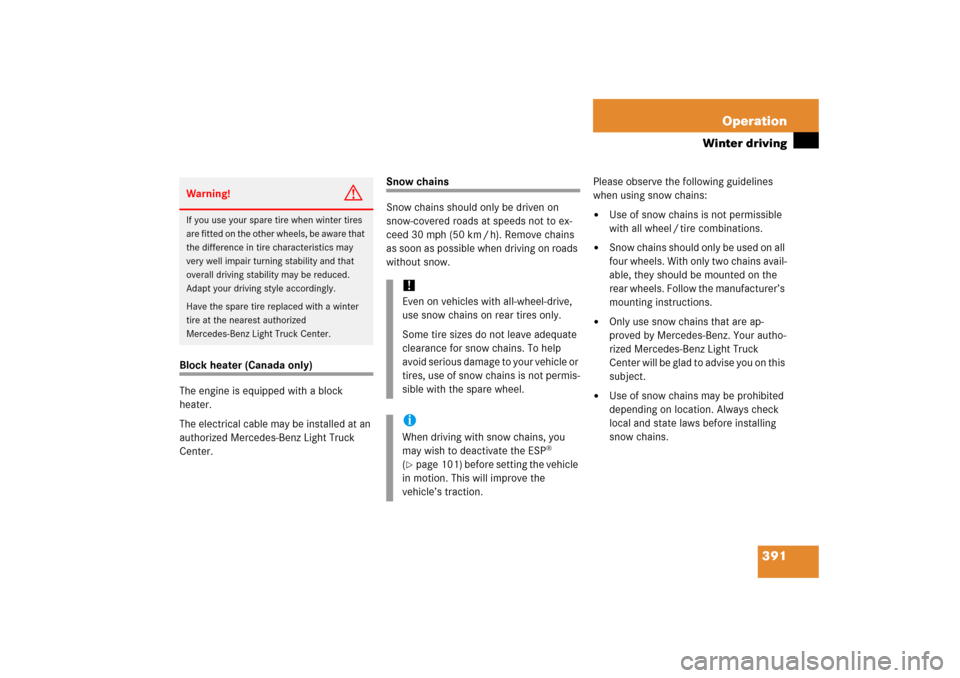
391 Operation
Winter driving
Block heater (Canada only)
The engine is equipped with a block
heater.
The electrical cable may be installed at an
authorized Mercedes-Benz Light Truck
Center.
Snow chains
Snow chains should only be driven on
snow-covered roads at speeds not to ex-
ceed 30 mph (50 km / h). Remove chains
as soon as possible when driving on roads
without snow.Please observe the following guidelines
when using snow chains:
�
Use of snow chains is not permissible
with all wheel / tire combinations.
�
Snow chains should only be used on all
four wheels. With only two chains avail-
able, they should be mounted on the
rear wheels. Follow the manufacturer’s
mounting instructions.
�
Only use snow chains that are ap-
proved by Mercedes-Benz. Your autho-
rized Mercedes-Benz Light Truck
Center will be glad to advise you on this
subject.
�
Use of snow chains may be prohibited
depending on location. Always check
local and state laws before installing
snow chains.
Warning!
G
If you use your spare tire when winter tires
are fitted on the other wheels, be aware that
the difference in tire characteristics may
very well impair turning stability and that
overall driving stability may be reduced.
Adapt your driving style accordingly.
Have the spare tire replaced with a winter
tire at the nearest authorized
Mercedes-Benz Light Truck Center.
!Even on vehicles with all-wheel-drive,
use snow chains on rear tires only.
Some tire sizes do not leave adequate
clearance for snow chains. To help
avoid serious damage to your vehicle or
tires, use of snow chains is not permis-
sible with the spare wheel.iWhen driving with snow chains, you
may wish to deactivate the ESP
®
(
�page 101) before setting the vehicle
in motion. This will improve the
vehicle’s traction.
Page 403 of 561
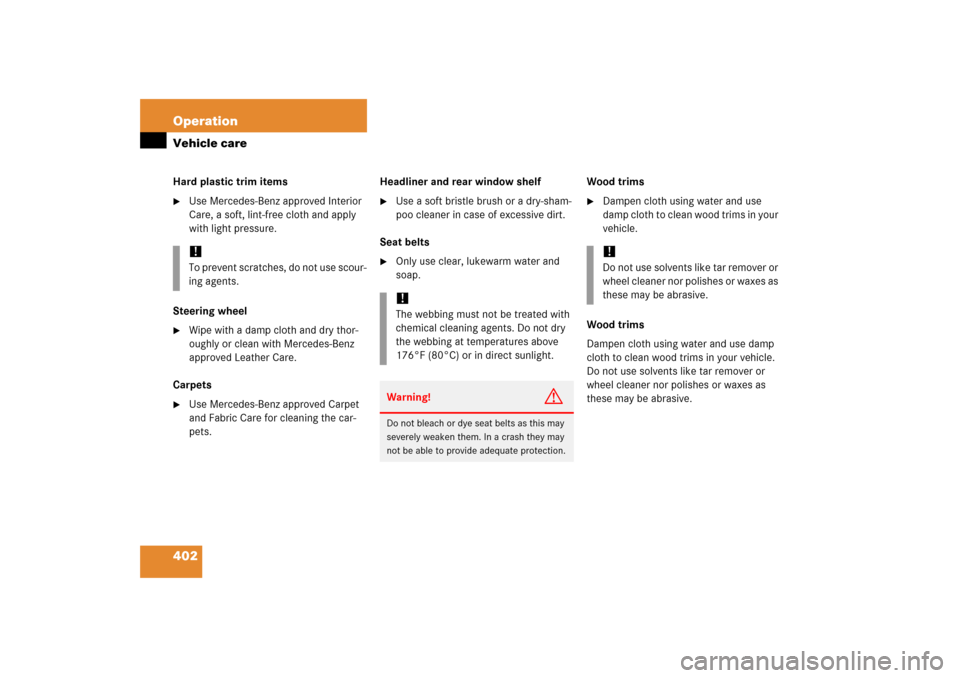
402 OperationVehicle careHard plastic trim items�
Use Mercedes-Benz approved Interior
Care, a soft, lint-free cloth and apply
with light pressure.
Steering wheel
�
Wipe with a damp cloth and dry thor-
oughly or clean with Mercedes-Benz
approved Leather Care.
Carpets
�
Use Mercedes-Benz approved Carpet
and Fabric Care for cleaning the car-
pets.Headliner and rear window shelf
�
Use a soft bristle brush or a dry-sham-
poo cleaner in case of excessive dirt.
Seat belts
�
Only use clear, lukewarm water and
soap.Wood trims
�
Dampen cloth using water and use
damp cloth to clean wood trims in your
vehicle.
Wood trims
Dampen cloth using water and use damp
cloth to clean wood trims in your vehicle.
Do not use solvents like tar remover or
wheel cleaner nor polishes or waxes as
these may be abrasive.
!To prevent scratches, do not use scour-
ing agents.
!The webbing must not be treated with
chemical cleaning agents. Do not dry
the webbing at temperatures above
176°F (80°C) or in direct sunlight.Warning!
G
Do not bleach or dye seat belts as this may
severely weaken them. In a crash they may
not be able to provide adequate protection.
!Do not use solvents like tar remover or
wheel cleaner nor polishes or waxes as
these may be abrasive.
Page 406 of 561
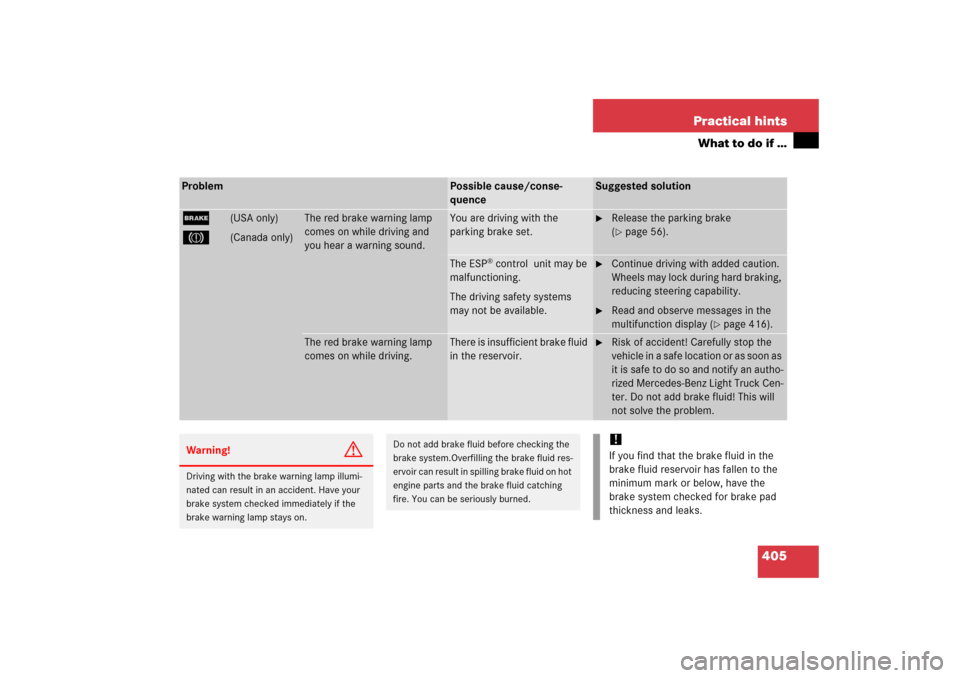
405 Practical hints
What to do if …
Problem
Possible cause/conse-
quence
Suggested solution
;
(USA only)
3
(Canada only)
The red brake warning lamp
comes on while driving and
you hear a warning sound.
You are driving with the
parking brake set.
�
Release the parking brake
(�page 56).
The ESP
® control unit may be
malfunctioning.
The driving safety systems
may not be available.
�
Continue driving with added caution.
Wheels may lock during hard braking,
reducing steering capability.
�
Read and observe messages in the
multifunction display (
�page 416).
The red brake warning lamp
comes on while driving.
There is insufficient brake fluid
in the reservoir.
�
Risk of accident! Carefully stop the
vehicle in a safe location or as soon as
it is safe to do so and notify an autho-
rized Mercedes-Benz Light Truck Cen-
ter. Do not add brake fluid! This will
not solve the problem.
Warning!
G
Driving with the brake warning lamp illumi-
nated can result in an accident. Have your
brake system checked immediately if the
brake warning lamp stays on.
Do not add brake fluid before checking the
brake system.Overfilling the brake fluid res-
ervoir can result in spilling brake fluid on hot
engine parts and the brake fluid catching
fire. You can be seriously burned.
!If you find that the brake fluid in the
brake fluid reservoir has fallen to the
minimum mark or below, have the
brake system checked for brake pad
thickness and leaks.
Page 407 of 561
406 Practical hintsWhat to do if …Problem
Possible cause/conse-
quence
Suggested solution
;
(USA only)
3
(Canada only)
-
v
The red brake warning lamp
comes on while driving. In
addition, the yellow ABS mal-
function indicator lamp, and
the yellow ESP
® warning lamp
come on and a warning will
sound.
A malfunction in the Electronic
Brake Proportioning
(�page 102) was detected.
�
Have the system checked at an autho-
rized Mercedes-Benz Light Truck
Center as soon as possible.
Failure to follow these instructions
increases the risk of an accident.
Page 410 of 561
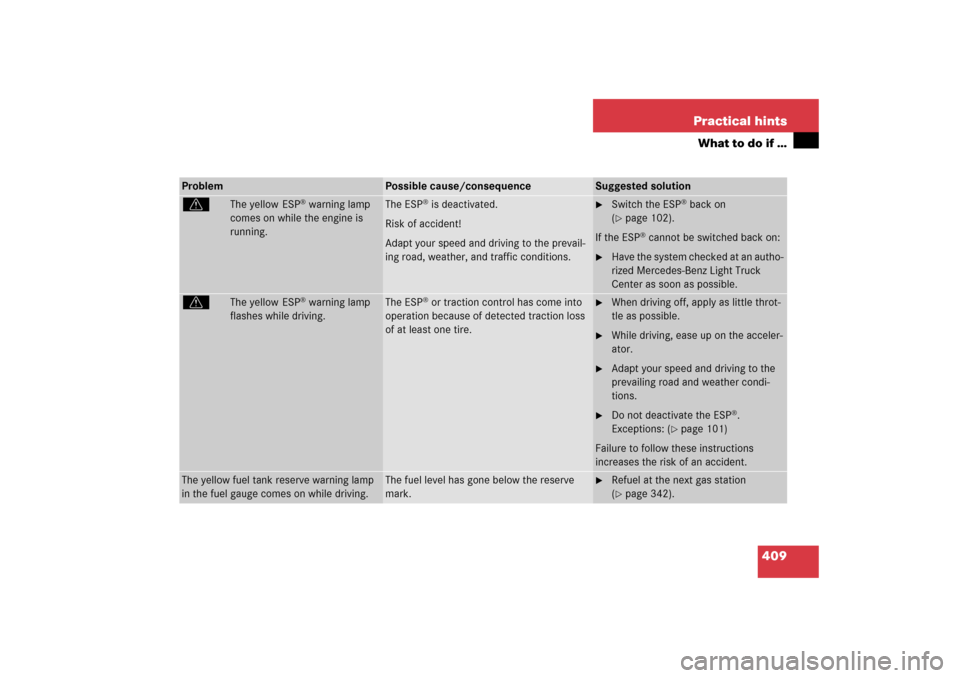
409 Practical hints
What to do if …
Problem
Possible cause/consequence
Suggested solution
v
The yellow ESP
® warning lamp
comes on while the engine is
running.
The ESP
® is deactivated.
Risk of accident!
Adapt your speed and driving to the prevail-
ing road, weather, and traffic conditions.
�
Switch the ESP
® back on
(
�page 102).
If the ESP
® cannot be switched back on:
�
Have the system checked at an autho-
rized Mercedes-Benz Light Truck
Center as soon as possible.
v
The yellow ESP
® warning lamp
flashes while driving.
The ESP
® or traction control has come into
operation because of detected traction loss
of at least one tire.
�
When driving off, apply as little throt-
tle as possible.
�
While driving, ease up on the acceler-
ator.
�
Adapt your speed and driving to the
prevailing road and weather condi-
tions.
�
Do not deactivate the ESP
®.
Exceptions: (
�page 101)
Failure to follow these instructions
increases the risk of an accident.
The yellow fuel tank reserve warning lamp
in the fuel gauge comes on while driving.
The fuel level has gone below the reserve
mark.
�
Refuel at the next gas station
(�page 342).
Page 412 of 561
411 Practical hints
What to do if …
Problem
Possible cause/consequence
Suggested solution
1
The red SRS indicator lamp comes
on while driving.
There is a malfunction in the restraint systems.
The air bags or emergency tensioning device
(ETDs) could deploy unexpectedly or fail to
deploy unexpectedly in an accident.
�
Drive with added caution to the
nearest authorized
Mercedes-Benz Light Truck
Center.
Warning!
G
In the event a malfunction of the SRS is indi-
cated as outlined above, the SRS may not be
operational. For your safety, we strongly
recommend that you visit an authorized
Mercedes-Benz Light Truck Center immedi-
ately to have the system checked, otherwise
the SRS may not be activated when needed
in an accident, which could result in serious
or fatal injury, or it might deploy unexpect-
edly and unnecessarily which could result in
an accident and/or injury to you or to
others.